... for beginners
This lesson is for beginner players learning their first guitar chords. We'll cover enough chord basics to get you prepared for more advanced lessons. After reading this article you should be able to play some basic chords as well as start to think like a true guitarist. Be sure to read the how to hold your guitar lesson before you continue.
What is a chord?
A chord is a group of three or more notes played simultaneously. Chords are usually strummed rhythmically in groups called chord progressions. An arpeggio is a chord whose notes are plucked one at a time.
Finger numbers on your fretting hand
To talk about chords we use numbers to refer to the fingers on our fretting hand (the hand that presses down notes).
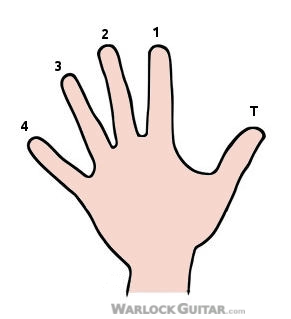
Helpful tips on playing chords.
- The more you practice the better you will get.
- Make sure you know how to tune a guitar.
- Keep fingernails short on your fretting hand.
- When fretting notes use the pads/tips of your fingers.
- Press fingers behind the frets (not on top of the frets).
- If you experience noise/buzzing when pressing a note, move your finger around to find that sweet spot just behind the fret.
- Press notes hard enough so that the fretted note ring.
- Use either a guitar pick (plectrum) or your fingernails on your other hand to strum notes. For this lesson I'll assume you are using a guitar pick.
- Strum the notes of a chord in one fluid downward (or upward) stroke with your strumming hand.
- When learning to strum a chord, make sure each note of the chord is sounding properly. Each note of the chord should ring clean and clear.
Basic guitar chords for beginners
Open chords are great first chords for beginners to learn because they are easier to play. On the guitar, open chords are simple chords that use one or more unfretted (open) strings as notes of the chord. Since some of the notes of the chord involve just playing the open strings, the chord is said to be in "open position". Some people call open chords "Cowboy chords" or Camp fire chords.
Simple Open G chord.
Probably the easiest open chord to play is a G chord that uses just one fretted note on the 3rd fret of the first string played with your 3rd finger and 3 open strings (D,G, and B strings). See the image below.
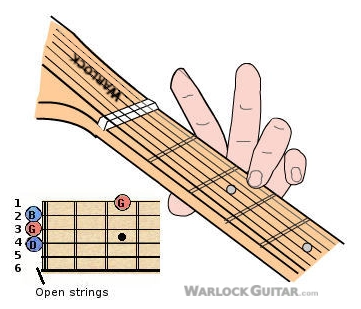
Open G chord on the 6th string.
Here is another open G chord that uses more strings and more fingers. This time all the strings are played and all the fingers are used. The open strings for this chord are the D and G strings. The fingers are placed as follows:
- 2nd finger on 6th string 3rd fret.
- 1st finger on 5th string 2nd fret.
- 3rd finger on 2nd string 3rd fret.
- 4th finger on 1st string 3rd fret.
- the chord diagram below.
- 3rd finger on 5th string 3rd fret.
- 2nd finger on 4th string 2nd fret.
- 1st finger on 2nd string 1st fret.
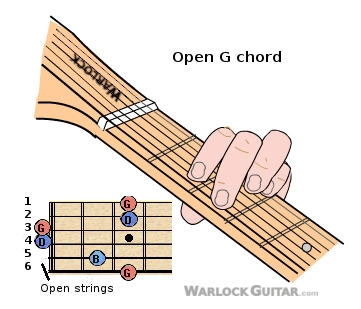
The Open C chord
The open C chord has two open strings the 3rd (G) string and the 1st (high e ) string.
The fingering for the Open C chord are:
See the chord diagram below.
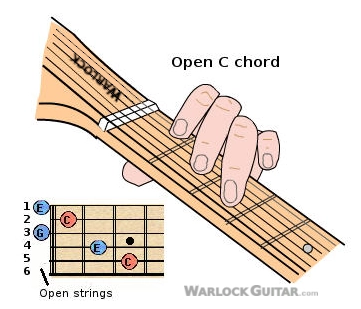
Basic chord strumming
Now that you know two chords you can start to practice strumming. To strum is to sound the chords. We will cover how to strum single chords and then switching chords with down and upward strums.
Downward strumPlay the G chord and strum all the notes of the chord by striking the strings all at the same time with the guitar pick using the steps below:
* Strike in a downwards motion towards the floor. * Count aloud 1 and, 2 and, 3 and, 4 and. Make sure to say the "and" after each number. * Strum the chord when you say each number. Let the chord ring through the "ands".
Things to practice while downward strumming
* Play the C chord and strum and count 1 and, 2 and, 3 and 4 and.
* Practice switching chords for each number. For example: Count the same way as before but strum G, C, G, C for numbers 1-4.
Upward strumRepeat all the steps above for downward strum but strum in an upward motion (from floor to sky).
Down Up strums* Count 1 and, 2 and, 3 and, 4 and - strum down on the numbers and strum up on the "ands".
* Play a G chord on the numbers using down strokes and a C chord on the upstrokes (on and).
Create your own strumming patterns
Once you are comfortable with down up strumming you can create your own strumming patterns. Strumming patterns help make your music unique. Experiment with the timing of individual strums. Try strumming a fast succession of down and up strums within the beat of the music. Also experiment with fast then slow strumming. Combining different combinations of strumming directions can really accent the chords you play. See my article on strumming patterns to learn more.
A minor chord
Let's add one more open chord that we can use to practice strumming, the A minor chord. Try adding this chord into your strums and counting.
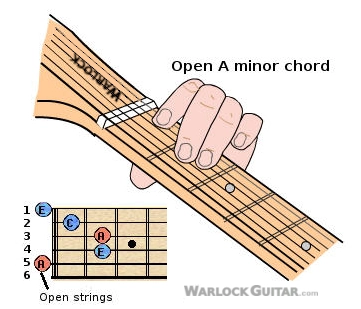
Want more guitar chords?
So far you have learned what a chord is and how to strum in up and downward strokes. You also learned the G and C and A minor open chords. There are many more chords to learn which you can find here on my guitar chord chart poster. You'll also want to learn easy guitar chords to make songs. Until next time, practice your chords and happy strumming!